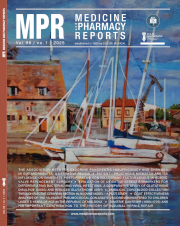Evaluation of oxidative stress biomarkers for differentiating bacterial and viral infections: a comparative study of glutathione disulfide (GSSG) and reduced glutathione (GSH)
DOI:
https://doi.org/10.15386/mpr-2821Keywords:
glutathione disulfide, reduced glutathione, viral infection, bacterial infection, biomarkerAbstract
Background and aims. This study evaluates the potential of oxidative stress biomarkers, specifically glutathione disulfide (GSSG) and reduced glutathione (GSH), for differentiating bacterial and viral infections. Oxidative stress plays a crucial role in the immune response, and glutathione is a key regulator of cellular redox balance. The aim was to assess whether differences in GSH and GSSG levels could be used as diagnostic markers for infection type.
Methods. A chemiluminescence-based method evaluated GSH and GSSG as potential biomarkers for distinguishing between bacterial and viral infections. The GSH and GSSG concentrations were analyzed across bacterial, viral, and control groups.
Results. Our data revealed significant differences in the GSH/GSSG ratio between the analyzed groups, with bacterial infections showing higher oxidative stress markers compared to viral infections. A combined analysis of GSH and GSSG concentrations, visualized through heatmaps and ROC curves, improved diagnostic accuracy, with clustering patterns distinguishing infection types.
Conclusions. These findings suggest that the GSH/GSSG ratio could be used as a biomarker in distinguishing between bacterial and viral infections, offering potential clinical applications for more accurate diagnosis. Further research is required to validate these results in larger cohorts and to explore the underlying mechanisms of oxidative stress in pathogen-specific immune responses.
Downloads
Published
How to Cite
Issue
Section
License
The authors are required to transfer the copyright of the published paper to the journal. This is done by agreeing to sign the Copyright Assignment Form. Whenever the case, authors are also required to send permissions to reproduce material (such as illustrations) from the copyright holder.

The papers published in the journal are licensed under a Creative Commons Attribution-NonCommercial-NoDerivatives 4.0 International License.

